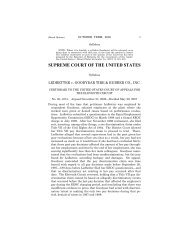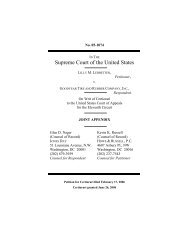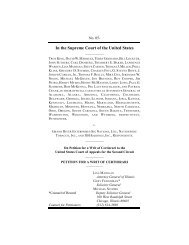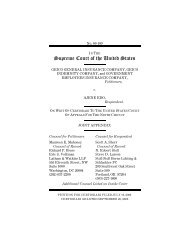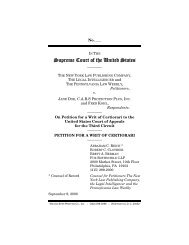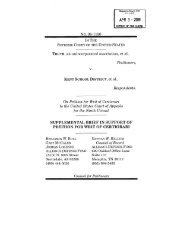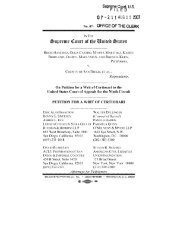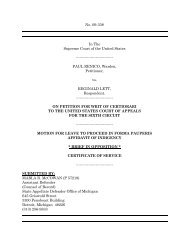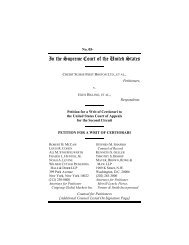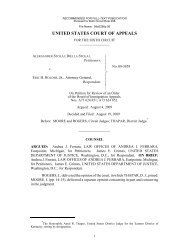LFP PUBLISHING GROUP, LLC, d/b/a Hustler ... - SCOTUSblog
LFP PUBLISHING GROUP, LLC, d/b/a Hustler ... - SCOTUSblog
LFP PUBLISHING GROUP, LLC, d/b/a Hustler ... - SCOTUSblog
Create successful ePaper yourself
Turn your PDF publications into a flip-book with our unique Google optimized e-Paper software.
No.<br />
<strong>LFP</strong> <strong>PUBLISHING</strong> <strong>GROUP</strong>, <strong>LLC</strong>,<br />
d/b/a <strong>Hustler</strong> Magazine,<br />
Petitioner,<br />
V¯<br />
MAUREEN TOFFOLONI, as Administrator<br />
and Personal Representative of the Estate of<br />
Nancy E. Ben¯it,<br />
Respondent.<br />
ON PETITION FOR WRIT OF CERTIORARI TO<br />
THE UNITED STATES COURT OF APPEALS<br />
FOR THE ELEVENTH CIRCUIT<br />
PETITION FOR WRIT OF CERTIORARI<br />
Paul J. Cambria, Jr.<br />
Counsel of Record<br />
LIPSITZ GREEN SCIME CAMBRIA, LLP<br />
42 Delaware Avenue, Suite 120<br />
Buffalo, Ne~v York 14202<br />
(716) 849-1333<br />
Counsel for Petitioner Dated: November 25, 2009<br />
THE LEX <strong>GROUP</strong> pc ¯ 1750 K Street N.W. O Suite 475 ¯ Washington, DC 20006<br />
(202) 955-0001 ¯ (800) 815-3791 O Fax: (202) 955-0022 ¯www.thelexgroup.com
Blank Page
QUESTIONS PRESENTED<br />
1. Whether the Eleventh Circuit erred in<br />
refusing to hold as a matter of law that the Freedom<br />
of the Press Clause of the First Amendment<br />
insulates Petitioner publisher from liability on<br />
Respondent Estate Administrator’s claim alleging<br />
that non-obscene nude photographs of her public<br />
figure Decedent, in an article in Petitioner’s national<br />
magazine on Decedent’s life and death, violated the<br />
Georgia common law posthumous right of publicity,<br />
where Decedent’s murder was a national news story<br />
of great public interest..<br />
2. Is publication of nude, non-obscene<br />
photographs of a murdered public figure as part of a<br />
national magazine article on her life and death to be<br />
deemed "newsworthy" and insulated from liability by<br />
the First Amendment right of freedom of the press,<br />
where Decedent’s murder by her public figure<br />
husband was a national news story?
ii<br />
DISCLOSURE OF PARTIES (RULE 14.1(b))<br />
The parties to the proceedings are: Petitioner (and<br />
Defendant) <strong>LFP</strong> Publishing Group, <strong>LLC</strong>; Respondent (and<br />
Plaintiff) Maureen Toffoloni; and Defendant Mark<br />
Samansky, who has not appeared in the action.
iii<br />
DISCLOSURE OF PARENT COMPANIES<br />
(RULE 29.6)<br />
Petitioner <strong>LFP</strong> Publishing Group, <strong>LLC</strong> is whollyowned<br />
by LE Publishing Advisors, <strong>LLC</strong>, which is in turn<br />
90% owned by L.F.P., Inc., which has no corporate parent.<br />
All such entities are privately owned.
Blank Page
iv<br />
TABLE OF CONTENTS<br />
Page(s)<br />
QUESTIONS PRESENTED .......................................i<br />
DISCLOSURE OF PARTIES (RULE 14.1(b)) .......... ii<br />
DISCLOSURE OF PARENT COMPANIES<br />
(RULE 29.6) ............................................................... iii<br />
TABLE OF CONTENTS ............................................iv<br />
TABLE OF AUTHORITIES ...................................... ix<br />
OPINIONS AND ORDERS BELOW ..........................1<br />
JURISDICTION OF THIS COURT ...........................2<br />
CONSTITUTIONAL AND STATUTORY<br />
PROVISIONS INVOLVED .........................................2<br />
STATEMENT OF THE CASE ....................................3<br />
A. Proceedings Below .................................3<br />
B. Factual Background ..............................6<br />
REASONS FOR GRANTING THE PETITION .........9
V<br />
CONTRARY TO THE<br />
ELEVENTH CIRCUIT<br />
OPINION, THE FIRST<br />
AMENDMENT RIGHT OF<br />
FREEDOM OF THE PRESS<br />
PROSCRIBES RESPONDENT<br />
ESTATE ADMINISTRATOR’S<br />
CLAIM FOR VIOLATION OF<br />
THE GEORGIA RIGHT OF<br />
PUBLICITY AS TO NUDE<br />
PHOTOGRAPHS OF HER<br />
DECEDENT ........................................... 9<br />
no The Benoit Nude<br />
Photographs are Protected<br />
by the First Amendment ............9<br />
Bo<br />
The Georgia Right of<br />
Publicity has an<br />
Exemption<br />
for<br />
Newsworthy Matters ................ 11
vi<br />
II.<br />
THE ELEVENTH CIRCUIT’S<br />
OPINION IS CONTRARY TO<br />
THE PRECEDENTS OF THIS<br />
COURT AND OTHER<br />
CIRCUITS DECLARING THAT<br />
UNDER THE FIRST<br />
AMENDMENT RIGHT OF<br />
FREEDOM OF THE PRESS,<br />
THE "NEWSWORTHINESS" OF<br />
NUDE PHOTOGRAPHS OF A<br />
MURDERED PUBLIC FIGURE<br />
USED TO ILLUSTRATE A<br />
MAGAZINE ARTICLE OF<br />
PUBLIC INTEREST ON<br />
DECEDENT’S LIFE AND<br />
DEATH IS TO BE<br />
DETERMINED BY THE<br />
PUBLISHER, NOT THE<br />
COURTS ..............................................13<br />
Under this Court’s<br />
Opinions<br />
"Newsworthiness" is<br />
Determined by Publishers ........ 13<br />
The Eleventh Circuit<br />
Misinterpreted the<br />
Constitutional Standard<br />
for Newsworthiness .................. 17<br />
Other Circuits Hold that<br />
"Newsworthiness" is to be<br />
Broadly Construed Under<br />
the First Amendment ............... 28
vii<br />
CONCLUSION ..........................................................32<br />
APPENDIX:<br />
Published Opinion of<br />
The United States Court of Appeals for the<br />
Eleventh Circuit<br />
entered June 25, 2009 ........................ḷa<br />
Order of<br />
The United States District Court for the<br />
Northern District of Georgia<br />
Re: Granting Defendants’ Motion to Dismiss<br />
entered October 6, 2008 .................... 24a<br />
Notice of Electronic Filing<br />
The United States District Court for the<br />
Northern District of Georgia<br />
Re: Civil Case Terminated<br />
entered October 7, 2008 ....................31a<br />
Order of<br />
The United States Court of Appeals for the<br />
Eleventh Circuit<br />
Re: Denying Petition for Rehearing and<br />
Rehearing En Banc<br />
entered August 27, 2009 ...................33a<br />
Judgment of<br />
The United States District Court for the<br />
Northern District of Georgia<br />
entered October 7, 2008 ....................35a
viii<br />
Verified Complaint,<br />
With Exhibits,<br />
entered February 6, 2008 ..................37a<br />
Exhibits:<br />
Bo<br />
Affidavit of James Daus<br />
sworn January 31, 2008 .........49a<br />
Co<br />
Letter to<br />
Sean Berries and David Carillo from<br />
Richard P. Decker<br />
Re: Objection to Publication of<br />
Any Photographs Depicting the<br />
Likeness of Nancy Benoit<br />
dated January 16, 2008 ..........53a<br />
Letter to<br />
Richard P. Decker from<br />
Paul J. Cambria, Jr.<br />
Re: Denying Request Not to<br />
Publish Photographs<br />
dated January 25, 2008 ..........55a<br />
Eo<br />
Ryan Clark, Nancy Benoit XXX<br />
Rated Photos to Appear in <strong>Hustler</strong><br />
Magazine, WrestleZone<br />
dated December 27, 2007 ........60a
Blank Page
ix<br />
TABLE OF AUTHORITIES<br />
Page(s)<br />
CASES<br />
Anderson v. Suiters,<br />
499 F.3d 1228 (10th Cir. 2007) ................30, 31<br />
Ashcroft v. Iqbal,<br />
129 S. Ct. 1937 (2009) ..................¯ ....................6<br />
Cabaniss v. Hinsle~,<br />
14 Ga. App. 367 (1966) ...................................17<br />
Douglass v. <strong>Hustler</strong> Magazine, Inc.,<br />
769 F.2d 1128 (7th Cir. 1985) ..................25, 26<br />
Gertz v. Robert Welch, Inc.,<br />
418 U.S. 323 (1974) ........................................16<br />
Harper & Rowe Publishers, Inc. v.<br />
Nation Enterprises,<br />
471 U.S. 539 (1985) ............................15, 19, 22<br />
<strong>Hustler</strong> Magazine v. Falwell,<br />
485 U.S. 46 (1988) ..........................................32<br />
Jenkins v. Georgia,<br />
418 U.S. 153 (1974) .......................................İ0<br />
Lerman v. Flynt Distribution Co.,<br />
745 F.2d 123 (2d Cir. 1984), cert. denied,<br />
471 U.S. 1054 (1985) ................................ 15-16
X<br />
Lowe v. Hearst Communications, Inc.,<br />
487 F.3d 246 (5th Cir. 2007) ....................28, 29<br />
Martin Luther King, Jr. Center v.<br />
American Heritage Products,<br />
250 Ga. 135 (1982) ................................. passim<br />
Montana v. San Jose Mercury News (1995)<br />
34 Cal.App.4th 790 .........................................31<br />
Pavesich v. New England Life Ins. Co.,<br />
122 Ga. 190 (1905) ....................... 11, 17, 18, 21<br />
Regan v. Time, Inc.,<br />
468 U.S. 641 (1984) .................................. 15, 19<br />
Reno v. American Civil Liberties Union,<br />
521 U.S. 844 (1997) ........................................10<br />
Sable Communications of California, Inc. v. FCC,<br />
492 U.S. 115 (1989) ........................................I0<br />
The Florida Star v. B.J.F.,<br />
491 U.S. 524 (1989) ........................................31<br />
Time, Inc. v. Hill,<br />
385 U.S. 374 (1967) ...................... 13, 14, 19, 27<br />
Time, Inc. v. Johnston,<br />
448 F.2d 378 (4th Cir. 1971) .....................27-28<br />
Toffoloni v. <strong>LFP</strong> Publishing Group, <strong>LLC</strong>,<br />
572 F.3d 1201 (llth Cir. 2009) .............ṗassim
xi<br />
Virginia v. Black,<br />
538 U.S. 343 (2003) ........................................10<br />
Waters v. Fleetwood,<br />
212 Ga. 161 (1956) ..................................passim<br />
William O’Neil & Co. v. Validea.com, Inc.,<br />
202 F. Supp. 2d 1113 (C.D. Cal. 2002) ..........28<br />
Zacchini v. Scripps-Howard Broadcasting Co.,<br />
433 U.S. 562 (1977) ..................................15, 19<br />
CONSTITUTIONAL PROVISIONS<br />
U.S. CONST. amend. I ........................................passim<br />
U.S. CONST. amend. XIV .......................................5, 10<br />
STATUTES<br />
28 U.S.C. § 1254 ..........................................................2<br />
28 U.S.C. § 1441(a) ..................................................2, 4<br />
RULES<br />
FED. R. CIv. P. 12(b)(6) .......................................1, 4, 8<br />
SuP. CT. R. 13 ..............................................................2<br />
ARTICLE<br />
William L. Prosser, "Privacy," 48<br />
California Law Review 383 (1960) ..................... 16, 24
xii<br />
TREATISE<br />
2 J. Thomas McCarthy,<br />
The Rights of Publicity and Privacy,<br />
(2d ed. 2009) .................................................. 10, 14, 24
OPINIONS AND ORDERS BELOW<br />
On October 6, 2008, the United States District<br />
Court for the Northern District of Georgia, Hon.<br />
Thomas W. Thrash, Jr., entered an Order with<br />
opinion granting Petitioner’s motion to dismiss the<br />
removed Complaint of Respondent Maureen<br />
Toffoloni, pursuant to Rule 12(b)(6) of the Federal<br />
Rules of Civil Procedure, for failure to state a claim<br />
for relief on Respondent’s single substantive claim<br />
that Petitioner allegedly violated her Decedent<br />
daughter’s Georgia common law posthumous right of<br />
publicity; on October 7, 2008, the Court Clerk<br />
entered Judgment dismissing the action. The Order<br />
and Judgment are reprinted herein at Appendix 24a,<br />
35a.<br />
On June 25, 2009, the United States Court of<br />
Appeals for the Eleventh Circuit entered a decision<br />
reversing the district court’s dismissal of the action<br />
and remanding the case for further proceedings, in<br />
an opinion reported as Toffoloni v. <strong>LFP</strong> Publishing<br />
Group, <strong>LLC</strong>, et al., 572 F.3d 1201. The opinion is<br />
reprinted herein at Appendix la.<br />
On August 27, 2009, the United States Court<br />
of Appeals for the Eleventh Circuit entered an Order<br />
denying Petitioner’s motion for Rehearing and<br />
Rehearing En Banc of its opinion reversing the<br />
district court’s dismissal of this action; said Order is<br />
reprinted herein at Appendix 33a.
JURISDICTION OF THIS COURT<br />
The Order of the United States Court of<br />
Appeals for the Eleventh Circuit denying Petitioner’s<br />
motion for rehearing and rehearing en banc of its<br />
earlier order reversing the order of the district court<br />
for the Northern District of Georgia dismissing<br />
Respondent’s complaint, was entered on August 27,<br />
2009. Jurisdiction of the United States Supreme<br />
Court is invoked pursuant to 28 U.S.C. § 1254 and<br />
Rule 13 of the Rules of the Supreme Court.<br />
Jurisdiction in the federal court of original<br />
instance was based on the removal provisions of 28<br />
U.S.C. § 1441(a), due to diversity of citizenship.<br />
CONSTITUTIONAL AND<br />
STATUTORY PROVISIONS INVOLVED<br />
United States Constitution, Amendment I<br />
Congress shall make no law respecting<br />
an establishment of religion, or<br />
prohibiting the free exercise thereof; or<br />
abridging the freedom of speech, or of<br />
the press; or the right of the people<br />
peaceably to assemble, and to petition<br />
the Government for a redress of<br />
grievances.
STATEMENT OF THE CASE<br />
This case presents an important issue of<br />
national significance - whether pursuant to the right<br />
of the freedom of the press as set forth in the First<br />
Amendment to the United States Constitution,<br />
Petitioner’s publication of non-obscene nude<br />
photographs of a public figure Decedent in its<br />
national magazine in a two-page article on her life<br />
and death, is immunized from liability for an alleged<br />
violation of the Georgia common law posthumous<br />
right of publicity, where Decedent’s death was a<br />
national news story. The case also raises the issue of<br />
whether the determination of "newsworthiness" of<br />
otherwise lawful nude photographs of a murdered<br />
public figure is to be made by the publisher, or by<br />
the courts. The opinion of the Eleventh Circuit<br />
refusing to recognize Petitioner’s First Amendment<br />
rights flies in the face of prior rulings of this Court<br />
and other Circuits. particularly insofar as the court<br />
of appeals’ decision is premised on the faulty notion<br />
that the First Amendment right to publish need be<br />
weighed against community morals.<br />
A. Proceedings Below<br />
This is a lawsuit brought by Respondent<br />
Maureen Toffoloni (hereinafter "Respondent") as<br />
Administrator of the Estate of her late daughter,<br />
Nancy Benoit (hereinafter "Decedent" or "Benoit")<br />
against Petitioner <strong>LFP</strong> Publishing Group, <strong>LLC</strong><br />
(hereinafter "Petitioner" or "<strong>LFP</strong>"), the publisher of<br />
the internationally known adult-themed gentlemen’s<br />
publication, <strong>Hustler</strong> magazine. The action concerns<br />
Petitioner’s publication of a two-page news article on
4<br />
the life and death of Decedent Benoit, published in<br />
the March, 2008 issue of <strong>Hustler</strong>, including fully and<br />
partially nude, posed photographs of Ms. Benoit<br />
extracted from a videotape previously made by<br />
Defendant Mark Samansky ("Samansky") 1 who is<br />
not a party to this Petition.<br />
Respondent commenced this action in the<br />
Fayette County, Georgia Superior Court seeking a<br />
temporary restraining order to prevent publication<br />
of the subject photographs of Benoit in <strong>Hustler</strong><br />
magazine, and asserting a single substantive cause<br />
of action against <strong>LFP</strong> for damages for its alleged<br />
violation of the Georgia common law posthumous<br />
right of publicity. Petitioner removed the case to the<br />
district court for the Northern District of Georgia<br />
based on diversity of citizenship, 28 U.S.C. §<br />
1441(a). 2 The district court denied Respondent’s<br />
motions for a temporary restraining order and for a<br />
preliminary injunction against publication, and she<br />
served her Complaint (Appendix D hereto).<br />
Petitioner <strong>LFP</strong> moved in the district court to<br />
dismiss the action for failure to state a claim for<br />
relief pursuant to Rule 12(b)(6) of the Federal Rules<br />
1 Defendant Samansky previously filed for bankruptcy in the<br />
District of Colorado where he presumably resided, has not<br />
appeared in this action, and is not a party to the instant<br />
Petition. Samansky is not represented by counsel for Petitioner<br />
<strong>LFP</strong>.<br />
~ Respondent alleges she is a resident of the State of Florida<br />
and that Decedent was a resident of the State of Georgia;<br />
Petitioner is a Delaware limited liability company with its<br />
principal offices located in California; the amount in<br />
controversy exceeds $75,000, exclusive of interest.
5<br />
of Civil Procedure. The lower court granted the<br />
dismissal motion on the grounds that the story of<br />
Decedent’s life and death, and the accompanying<br />
nude photographs of Decedent, were newsworthy<br />
and outside the ambit of the Georgia right of<br />
publicity. The district court found it was undisputed<br />
by Respondent that "Ms. Benoit’s death was a<br />
’legitimate matter of public interest and concern,’"<br />
and accordingly "publication of Ms. Benoit’s nude<br />
photographs cannot be described as a mere<br />
commercial benefit for [<strong>LFP</strong>]" (28a) - which would be<br />
a prerequisite for a right of publicity claim. Thus,<br />
<strong>LFP</strong>’s publication of the subject photographs was<br />
protected by "the freedom of press exception to the<br />
right of publicity" as a matter of law (29a).<br />
Respondent appealed, and an Eleventh Circuit<br />
panel reversed and reinstated the Complaint, in an<br />
opinion published at 572 F.3d 1201. That court held<br />
that the photographs of Benoit taken more than 20<br />
years before their publication "were neither related<br />
in time nor concept" to the story of admitted public<br />
interest, and therefore proclaimed that "these<br />
photographs do not qualify for the newsworthy<br />
exception to the right of publicity" (572 F.3d at<br />
1213). Central to the court’s analysis was its opinion<br />
that right of privacy protected by the Due Process<br />
Clause of the Fourteenth Amendment is as<br />
established and fundamental as the right of freedom<br />
of speech and of the press explicitly set forth in the<br />
First Amendment. Consequently, since the right of<br />
privacy impliedly guaranteed by the Due Process<br />
Clause exists on the same constitutional plane as the<br />
explicit rights stated in the First Amendment, the<br />
court reasoned that Petitioner’s constitutional right
6<br />
to publish must be balanced against "that which<br />
resonates with our community morals." (572 F.3d at<br />
1208). The court did not discuss the First<br />
Amendment implications or the chilling effect of its<br />
opinion, but remanded to the trial court for further<br />
proceedings (23a). <strong>LFP</strong> then petitioned the Eleventh<br />
Circuit for a rehearing or rehearing of its decision en<br />
banc, which petition was denied in an Order of<br />
August 27, 2009 (33a).<br />
<strong>LFP</strong> now petitions this Court to grant a writ<br />
of certiorari as to the Eleventh Circuit panel decision<br />
reversing dismissal of the instant Complaint, on<br />
grounds of Petitioner’s First Amendment right of<br />
freedom of the press.<br />
B. Factual Background<br />
On Petitioner’s motion to dismiss for failure to<br />
state a claim for relief, the facts are taken from the<br />
Respondent’s Complaint, filed in the Georgia<br />
Superior Court (37a), and the opinions already<br />
issued herein (24a-30a; 1a-23a). 3<br />
Respondent Toffoloni is the mother and<br />
Administrator of the Estate of the late Nancy Benoit.<br />
In June, 2007 (A-38, 15), Benoit and her son were<br />
apparently murdered by their respective husband<br />
and father Christopher Benoit, a well-known<br />
professional wrestler, who then committed suicide<br />
3 Under the familiar federal standard, on a motion to dismiss<br />
the courts must take all factual allegation of the complaint as<br />
true, but need not accept as true "a legal conclusion couched as<br />
a factual allegation." Ashcroft v. Iqbal, 129 S. Ct. 1937, 1949-50<br />
(2009).
(41a, 15; 2a). At the time of her murder, Benoit<br />
was herself a model and professional woman<br />
wrestler, and a well-known public figure in her own<br />
right (41a, 15).<br />
Some 20 years prior to her death, Benoit had<br />
voluntarily posed fully and partially nude for<br />
photographs and a videotape, taken by named<br />
Defendant Mark Samansky, a professional<br />
photographer, in the presence of her then- husband<br />
(38a, 3; 40a, 9; 50a, 5). After the photographs<br />
and videotape were taken, Benoit allegedly changed<br />
her mind about having the pictures published, and<br />
instead requested Samansky to destroy them. While<br />
allegedly agreeing to do so, Samansky apparently<br />
destroyed the photographs but kept the videotape<br />
(40a-41a, 12,13; 41a, 16). After the Benoit<br />
murder-suicide became national and international<br />
news (2a), Samansky retrieved the videotape,<br />
extracted photographs therefrom (including the nude<br />
photographs of Benoit taken as a young woman), and<br />
conveyed the right to publish his copyrighted images<br />
to Petitioner <strong>LFP</strong> for publication in <strong>Hustler</strong><br />
Magazine (41a-42a, 16,17).<br />
When Respondent discovered the forthcoming<br />
publication of the nude photos of Benoit in <strong>Hustler</strong>,<br />
she demanded that publication cease (42a, 18), but<br />
Petitioner refused her request based on its rights to<br />
publish newsworthy material under Georgia law and<br />
the First Amendment, as advised by its counsel (55a-<br />
59a); moreover, publication had already occurred.<br />
Respondent then brought suit in Georgia state court,<br />
seeking a temporary restraining order against the<br />
publication, and Petitioner removed the action to
federal court by reason of diversity of citizenship. By<br />
the time district court hearings were held in<br />
February 2008 on Respondent’s motions for a<br />
temporary restraining order and later a preliminary<br />
injunction, the subject nude photographs of Decedent<br />
Benoit had already been published in the March<br />
2008 issue of <strong>Hustler</strong>, 4 rendering the motions moot;<br />
the motions for injunctive relief were then denied by<br />
the district court (25a).<br />
Respondent asserted a single substantive<br />
cause of action for monetary damages, based on<br />
<strong>LFP</strong>’s alleged violation of Decedent Nancy Benoit’s<br />
right of publicity under Georgia common law (45a,<br />
30). Petitioner <strong>LFP</strong> moved to dismiss pursuant to<br />
Rule 12(b)(6), which motion was granted by the<br />
court, Hon. Thomas W. Thrush, and Respondent<br />
appealed (3a). The dismissal was reversed by the<br />
Eleventh Circuit panel on June 25, 2009, reported at<br />
572 F.3d 1201, and remanded to the district court t~or<br />
further proceedings (23a). A petition for rehearing<br />
and rehearing en banc was denied on September 25,<br />
2009 (33a).<br />
The nude pictures of Benoit had been<br />
voluntarily posed in the presence of her thenhusband<br />
(50a, 5), were not obscene, and were<br />
published as part of a full two-page news article on<br />
her life and death in the March 2008 issue of <strong>Hustler</strong><br />
Magazine. Benoit was admittedly a public figure<br />
prior to her death, and her murder was concededly a<br />
media story of great public interest. Petitioner <strong>LFP</strong><br />
4 <strong>Hustler</strong> magazine is published 13 times a year (12 monthly<br />
issues plus an extra Holiday issue); thus a new issue come out<br />
every four weeks.
9<br />
asserts that as part of a news story of legitimate<br />
public concern, the article did not violate the Georgia<br />
right of publicity. However, even if the photographs<br />
are assumed to violate Georgia law for purposes of<br />
this Petition, a finding of liability in this action<br />
would be in violation of <strong>LFP</strong>’s right of freedom of the<br />
press pursuant to the First Amendment to the<br />
United States Constitution, and result in a chilling<br />
effect on publishers in general, not just adult-themed<br />
magazines such as <strong>Hustler</strong>. Moreover, the decision<br />
of whether or not to publish otherwise lawful, nonobscene<br />
photographs of a deceased public figure<br />
illustrating a story of public interest should be made<br />
by the editors of <strong>Hustler</strong> Magazine and other<br />
publishers, and not by the courts, as has been stated<br />
by this and other courts in various opinions.<br />
REASONS FOR GRANTING THE PETITION<br />
CONTRARY TO THE ELEVENTH<br />
CIRCUIT OPINION, THE FIRST<br />
AMENDMENT RIGHT OF FREEDOM OF<br />
THE PRESS PROSCRIBES<br />
RESPONDENT<br />
ESTATE<br />
ADMINISTRATOR’S CLAIM FOR<br />
VIOLATION OF THE GEORGIARIGHT<br />
OF PULICITY AS TO NUDE<br />
PHOTOGRAPHS OF HER DECEDENT.<br />
The Benoit Nude Photographs are<br />
Protected by the First Amendment.<br />
It is long settled law that the First<br />
Amendment to the United States Constitution,<br />
stating as relevant: "Congress shall make no law...
10<br />
abridging the freedom of speech or of the press .... "<br />
applies to the states as well as to the federal<br />
government by virtue of the Fourteenth Amendment.<br />
See, e.g., Virginia v. Black, 538 U.S. 343, 358 (2003).<br />
It is also established that even indecent, non-obscene<br />
sexual expression is protected by the First<br />
Amendment. Reno v. American Civil Liberties<br />
Union, 521 U.S. 844, 874-75 (1997); Sable<br />
Communications of California, Inc. v. FCC, 492 U.S.<br />
115, 126 (1989). The protection of the First<br />
Amendment has been specifically applied to nudity.<br />
See, Jenkins v. Georgia, 418 U.S. 153 (1974). Thus,<br />
the nude photographs of Decedent Benoit, which are<br />
not obscene, constitute expression protected by the<br />
First Amendment with regard to Respondent’s<br />
instant claim.<br />
Here, Respondent Toffoloni asserts a single<br />
substantive cause of action for violation of Decedent<br />
Nancy Benoit’s right of publicity (45a, 30), first<br />
recognized as a posthumous common law right in<br />
Georgia in Martin Luther King, Jr. Center v.<br />
American Heritage Products, Inc., 250 Ga. 135<br />
(1982). It may be noted that Respondent does not<br />
and can not assert a substantive claim for an alleged<br />
violation of the Georgia right of privacy, since such a<br />
cause of action expires with the death of the person<br />
whose right of privacy has purportedly been violated.<br />
See 2 J. Thomas McCarthy, The Rights of Publicity<br />
and Privacy, § 9:1, pp. 394-95 (2d ed. 2009) [Privacy<br />
rights protect human dignitary values measured by<br />
mental and physical suffering and reputational<br />
damages; "Such classic ’privacy’ rights die with the<br />
person whose privacy was allegedly invaded."].
11<br />
Accord, Pavesich v. New England Life Ins. Co., 122<br />
Ga. 190, 210 (1905).<br />
Bo<br />
The Georgia Right of Publicity has<br />
an Exemption for Newsworthy<br />
Matters.<br />
Even aside from the First Amendment, the<br />
Georgia common law right of publicity carries its<br />
own newsworthiness exemption from liability. Thus,<br />
in the leading Martin Luther King case, supra, the<br />
Georgia Supreme Court found liability for<br />
defendant’s commercial sale of busts of Dr. King over<br />
the plaintiffs objections. In first enunciating its<br />
authorization of posthumous publicity rights, the<br />
Georgia court expressly limited that right of<br />
publicity to those circumstances in which use of the<br />
claimant’s name or photograph "is not authorized as<br />
an exercise of freedom of the press." 250 Ga. at 143.<br />
Thus, even aside from First Amendment rights,<br />
Georgia case law itself expressly limits the state’s<br />
right of publicity claim to actions that do not violate<br />
the freedom of the press.<br />
Here, the district court held that this<br />
limitation would necessarily be fatal to Toffoloni’s<br />
claim; otherwise, "no newspaper might identify any<br />
person or any incident of his life without accounting<br />
to him for violation of his ’right of publicity’." (29a),<br />
citing the Martin Luther King decision, 250 Ga. at<br />
151-52.<br />
In its opinion below, the Eleventh Circuit<br />
itself recognized that Georgia follows a<br />
"newsworthiness" exception to an action asserting
12<br />
the right of publicity. 572 F.3d at 1208. As the court<br />
below stated:<br />
The Supreme Court of Georgia has held<br />
that "where an incident is a matter of<br />
public interest, or the subject matter of<br />
a public investigation, a publication in<br />
connection therewith can be a violation<br />
of no one’s legal right of privacy."<br />
Waters v. Fleetwood, 212 Ga. 161, 91<br />
S.E.2d 344, 348 (1956). (572 F.3d at<br />
1208).<br />
Georgia’s newsworthiness exemption was<br />
summarized by the Eleventh Circuit: "where a<br />
publisher may be precluded by the right of publicity<br />
from publishing one’s image for purely financial<br />
gain, as in an advertisement, where the publication<br />
is newsworthy, the right of publicity gives way to<br />
freedom of the press." (572 F.3d at 1208).<br />
Thus, the Eleventh Circuit correctly<br />
recognized - at least in principle - the<br />
"newsworthiness" exception to the Georgia right of<br />
publicity. Where that court went terribly wrong,<br />
however, was its determination that even though the<br />
nude photographs of Benoit were used as part of an<br />
article on a deceased public figure whose murder<br />
was unquestionably a matter of great public interest<br />
- rather than for a purely commercial or advertising<br />
use - it nevertheless found that said photographs,<br />
"do not qualify for the newsworthiness exception to<br />
the right of publicity." (572 F.3d at 1213). Under<br />
applicable law and precedent, that determination<br />
was erroneous.
13<br />
II.<br />
THE ELEVENTH CIRCUIT’S OPINION IS<br />
CONTRARY TO THE PRECEDENTS OF<br />
THIS COURT AND OTHER CIRCUITS<br />
DECLARING THAT UNDER THE FIRST<br />
AMENDMENT RIGHT OF FREEDOM OF<br />
THE PRESS, THE "NEWSWORTHINESS"<br />
OF NUDE PHOTOGRAPHS OF A<br />
MURDEREDPUBLIC FIGURE USED TO<br />
ILLUSTRATE A MAGAZINE ARTICLE<br />
OF PUBLIC INTEREST ON DECEDENT’S<br />
LIFE AND DEATH IS TO BE<br />
DETERMINED BY THE PUBLISHER,<br />
NOT THE COURTS.<br />
A. Under this Court’s Opinions<br />
"Newsworthiness" is Determined<br />
by Publishers.<br />
The crux of this Petition is a seemingly simple<br />
question. Given an article of public interest on the<br />
life and murder of a public figure, who should decide<br />
whether or not the publication of non-obscene, posed<br />
nude photographs of her to illustrate the article is<br />
"newsworthy"? Such a determination must be made<br />
within the limits of the freedom of the press afforded<br />
to publishers by the First Amendment to the United<br />
States Constitution - the Crown Jewel of the Bill of<br />
Rights.<br />
It is long-established in this country that First<br />
Amendment guarantees of freedom of speech and of<br />
the press are not confined to political expression and<br />
comment, but go far beyond that. As stated by<br />
Justice Brennan in the seminal opinion in Time, Inc.
14<br />
v. Hill, 385 U.S. 374 (1967), regarding the<br />
widespread publication of personal matters:<br />
One need only pick up any newspaper<br />
or magazine to comprehend the vast<br />
range of published matter which<br />
exposes persons to public view, both<br />
private citizens and public officials.<br />
Exposure of the self to others in varying<br />
degrees is a concomitant of life in a<br />
civilized community. The risk of this<br />
exposure is an essential incident of life<br />
in a society which places a primary<br />
value on freedom of speech and of press.<br />
Freedom of discussion, if it would fulfill<br />
its historic function in this nation, must<br />
embrace all issues about which<br />
information is needed or appropriate to<br />
enable the members of society to cope<br />
with the exigencies of their period. (385<br />
U.S. at 388).<br />
Given this broad language as to what is<br />
protected by Constitutional freedom of the press, as<br />
stated by Professor McCarthy, it is no wonder that:<br />
"Judges are uncomfortable with deciding that some<br />
information which is demanded by some people is of<br />
’no concern’ to the public." Accordingly, "most judges<br />
in fact have adopted a laissez faire attitude and<br />
’simply accept the press’s judgment about what is<br />
and what is not newsworthy.’" 2 J. Thomas<br />
McCarthy, The Rights of Publicity and Privacy, §<br />
8:51, p.181 (2d ed. 2009).
15<br />
In this case, the Eleventh Circuit panel<br />
concluded on its review of the subject article that the<br />
nude photographs of Benoit published by Petitioner<br />
were not incidental to a newsworthy article; rather,<br />
the article was incidental to the photographs. (572<br />
F.3d at 1213). However, such a determination is<br />
contrary to the spirit and opinions of this Court and<br />
other circuits, as to who should decide<br />
newsworthiness under the First Amendment.<br />
Thus, in Regan v. Time, Inc., 468 U.S. 641<br />
(1984), this Court recognized that, "A determination<br />
concerning the newsworthiness or educational value<br />
of a photograph cannot help be based on the content<br />
of the photograph and the message it delivers." 468<br />
U.S. at 648. Accordingly, the government’s approval<br />
of a photograph is often message - dependent, and<br />
therefore discriminates based on the content of the<br />
message, which cannot be tolerated under the First<br />
Amendment. 468 U.S. at 648-49.<br />
Shortly thereafter, the Court, citing the<br />
Second Circuit dissent in the opinion below, stated:<br />
"As Judge Meskill wisely noted, ’[c]ourts should be<br />
chary of deciding what is and what is not news.’<br />
(Citations omitted)." Harper & Rowe Publishers,<br />
Inc. v. Nation Enterprises, 471 U.S. 539, 561 (1985). 5<br />
Accord, Lerman v. Flvnt Distributing Co., 745 F.2d<br />
123, 139 (2d Cir. 1984) ["[C]ourts are, and should be,<br />
5 To the extent <strong>Hustler</strong> magazine may be considered by some a<br />
publication not primarily known for presenting "hard" news, it<br />
is long-established that "entertainment, as well as news, enjoys<br />
First Amendment protection." Zacchini v. Scripps-Howard<br />
Broadcasting Co., 433 U.S. 562, 578 (1977). <strong>Hustler</strong> magazine<br />
regularly presents social and political news and commentary<br />
within its pages, in addition to entertainment news.
16<br />
reluctant to define newsworthiness"], cert. denied,<br />
471 U.S. 1054 (1985).<br />
In a somewhat different context involving<br />
remedies for defamatory statements against private<br />
individuals, this Court earlier wrote generally with<br />
regard to reporting on matters of public interest, as<br />
herein:<br />
...it would occasion the additional<br />
difficulty of forcing state and federal<br />
judges to decide on an ad hoc basis<br />
which publications address issues of<br />
"general or public interest" and which<br />
do not--to determine, in the words of<br />
Mr. Justice Marshall, "what<br />
information is relevant to selfgovernment."<br />
We doubt the wisdom of<br />
committing this task to the conscience<br />
of judges. (Citation omitted).<br />
Gertz v. Robert Welch, Inc., 418 U.S. 323, 346<br />
(1974).<br />
The foregoing has been largely summarized by<br />
Dean Prosser in a well-known law review article,<br />
William L. Prosser, "Privacy," 48 California Law<br />
Review, 383, 412 (1960)["[t]o a very great extent, the<br />
press, with its experience or instinct as to what its<br />
readers will want, has succeeded in making its own<br />
definition of news"].
17<br />
B. The Eleventh Circuit<br />
Misinterpreted the Constitutional<br />
Standard for Newsworthiness.<br />
Notwithstanding the foregoing caveats by this<br />
Court as to avoiding judicial interference with a<br />
publisher’s determinations of what it deems<br />
"newsworthy," the Eleventh Circuit has nevertheless<br />
leapt into the fray with its own interpretation<br />
thereof.<br />
Thus, the court below initially went through<br />
concepts of privacy, and the history of Georgia<br />
common law with regard to the right of privacy<br />
evolving into the right of publicity, from the early<br />
decision in Pavesich v. New England Life Ins. Co.,<br />
122 Ga. 190 (1905) [seminal case in Georgia right of<br />
privacy], through Cabaniss v. Hipslev, 114 Ga. App.<br />
367 (1966) [first Georgia appellate court to recognize<br />
a separate right of publicity], through the leading<br />
case of Martin Luther King, Jr. Center v. American<br />
Heritage Products, Inc., 250 Ga. 135 (1982) [setting<br />
parameters for Georgia common law posthumous<br />
right of publicity].<br />
In the Martin Luther King case, the Georgia<br />
Supreme Court indicated that a right of publicity<br />
existed for public and private citizens alike not to<br />
have their names and photographs used for the<br />
financial gain of the defendant without consent,<br />
"where such use is not authorized as an exercise of<br />
freedom of the press." 250 Ga. at 143. Thus, the<br />
Georgia Supreme Court recognized that the right of<br />
publicity was necessarily subordinated to the<br />
freedom of the press, and required a showing of
18<br />
financial gain by the unauthorized user. It is<br />
noteworthy that the relevant early Georgia cases<br />
such as Pavesich, supra, involved the right of privacy<br />
where the plaintiffs photograph was used in a<br />
commercial advertisement without permission.<br />
Similarly, in the Martin Luther King case, a bust of<br />
the late Dr. King was produced and sold by<br />
defendant without authorization in a direct profitmaking<br />
activity without any specific public interest<br />
component. That is not the case here, where the<br />
photographs of decedent Nancy Benoit were used to<br />
illustrate a magazine article of public interest on her<br />
life and death, as opposed to being part of an<br />
advertisement or the direct sale of a product bearing<br />
her name or likeness.<br />
These cases finding liability stand in stark<br />
contrast to the Georgia Supreme Court decision in<br />
Waters v. Fleetwood, 212 Ga. 161 (1956). There, the<br />
court held there was no actionable right of privacy<br />
under Georgia law, even for publication of<br />
gratuitous, sensational photographs alongside a<br />
legitimate news article. Rather, the court denied a<br />
mother’s claim to recover damages for invasion of<br />
privacy under Georgia law arising from a<br />
newspaper’s publication and sale of photographs of<br />
the partially decomposed body of her 14-year-old<br />
murder victim daughter, after the body was removed<br />
from a river. 212 Ga. at 161-62. In addition to the<br />
newspaper article, the court also insulated from<br />
liability the defendant newspaper’s separate sale of<br />
copies of the photographs which had appeared in the<br />
newspaper aside from the newspaper story, stating<br />
that "the same rule must apply as would apply to the<br />
publication of the photographs in the paper." 212
19<br />
Ga. at 167. Petitioner submits that the photographs<br />
of the decomposed body of a young girl (which were<br />
not voluntarily posed) are far more egregious than<br />
the nude photographs of Decedent and public figure<br />
Nancy Benoit as part of an article of general public<br />
interest on her life and death.<br />
Nevertheless, assuming arguendo that the<br />
Eleventh Circuit correctly found the subject nude<br />
photographs of Benoit violated the Georgia right of<br />
publicity for purposes of this Petition, such a claim<br />
would still be an unconstitutional violation of<br />
Petitioner <strong>LFP</strong>’s First Amendment right of freedom<br />
of the press.<br />
In seemingly seeking to become Editor-in-<br />
Chief of <strong>Hustler</strong> magazine, the Eleventh Circuit has<br />
arrogated to itself the decision that publication of<br />
the subject nude photographs of Nancy Benoit was<br />
not newsworthy within the protection of the First<br />
Amendment freedom of the press. In its analysis,<br />
the court failed to cite any of the leading Supreme<br />
Court decisions in this area set forth above, such as<br />
Hill, Re~an, or Harper & Rowe. Rather, the only<br />
opinion of this Court cited below was its decision in<br />
Zacchini v. Scripps-Howard Broadcast Co., 433 U.S.<br />
562 (1977), that the right of publicity protects the<br />
economic value inherent in the right of publicity.<br />
572 F.3d at 1207. However, that case is entirely<br />
distinguishable on its facts, involving the<br />
defendant’s videotaping and televising the plaintiffs<br />
complete "human cannonball" entertainment act<br />
without his permission. The Court’s 5-4 decision<br />
narrowly ruled that a television station’s<br />
appropriating a performer’s entire commercial act
20<br />
crossed the line and was not insulated from liability<br />
by the First Amendment. Here, there is little or no<br />
commercial value to the nude images of Benoit, since<br />
her mother, Respondent Toffoloni, has only indicated<br />
a desire to suppress the nude photographs of her<br />
daughter, not to publish them.<br />
Moreover, the Eleventh Circuit opined<br />
without reference to legal authority, that the rights<br />
of freedom of speech and press guaranteed by the<br />
First Amendment and the right of privacy<br />
guaranteed by the Due Process Clause are equal<br />
fundamental constitutional rights that must be<br />
balanced in a particular case by weighing the First<br />
Amendment right of publication against the<br />
community morals. 572 F.3d at 1207-08. It then<br />
stated that the Georgia courts have accordingly<br />
adopted the "newsworthiness" exception to the right<br />
of publicity, citing Waters v. Fleetwood, supra, 532<br />
F.3d at 1208.<br />
The circuit court substantially misapprehends<br />
the law herein. While courts have duly recognized a<br />
constitutional right of privacy under certain<br />
circumstances, as already demonstrated above, the<br />
right of privacy is a personal one that dies with the<br />
individual who possesses it. Rather, this case<br />
involves the very different right of publicity, which<br />
in Georgia survives the death of the publicity right<br />
holder (here Nancy Benoit) because it is a state<br />
property right - as opposed to a personal right - that<br />
may be assigned or devised to others. However, the<br />
Georgia right of publicity is merely a creation of the<br />
state common law, and therefore cannot be deemed a<br />
fundamental constitutional right capable of
21<br />
counterbalancing and outweighing <strong>LFP</strong>’s express<br />
First Amendment right of freedom of the press to<br />
publish an article of public interest on the highly<br />
publicized murder of a public figure. Thus, there can<br />
be no balancing of rights to be applied in this case.<br />
Here, the explicit First Amendment right of freedom<br />
of the press must prevail over the Decedent’s<br />
common law posthumous right of publicity, or<br />
perhaps some amorphous claim of substantive due<br />
process, and state law must yield to the federal<br />
Constitution.<br />
The Eleventh Circuit itself, following Georgia<br />
law, agreed that even a commercial use in a right of<br />
publicity context must give way to the freedom of the<br />
press for a newsworthy publication. However, its<br />
referenced Georgia cases of Pavesich v. New<br />
England Life Ins. Co., 122 Ga. 190 (1905), and<br />
Waters v. Fleetwood, 212 Ga. 161 (1956), cited by the<br />
court (572 F.3d at 1708), primarily equate a<br />
commercial use to an advertisement. G Here, it is<br />
undisputed that the subject photographs were part<br />
of an article on a matter of public interest, and not in<br />
an advertisement or a direct commercial sale of any<br />
kind.<br />
Again, the Eleventh Circuit, without any<br />
attempt to analyze-this Court’s First Amendment<br />
freedom of the press cases disfavoring a judicial<br />
determination of newsworthiness, conjured up a<br />
"straw man" to knock down, asserting that had <strong>LFP</strong><br />
published the nude photographs of Benoit by<br />
(~ Martin Luther King~ Jr. Center v. American Heritage<br />
Products, Inc., 250 Ga. 135 (1982), involved a direct commercial<br />
sale of a bust in the image of Dr. King.
22<br />
themselves without a corresponding article, that<br />
publication would unquestionably not qualify for the<br />
newsworthiness exception. 572 F.3d at 1209.<br />
However, that is just not the case herein - the<br />
photographs were part of a full two-page article on<br />
Benoit’s life and death. Thus, the Eleventh Circuit<br />
was left with the task of asserting that the<br />
publication of the photographs was merely incidental<br />
to its commercial purpose. The court contended<br />
that:<br />
Although <strong>LFP</strong> argues that the<br />
photographs were illustrative of the<br />
substantive, biographical article<br />
included in <strong>Hustler</strong>, our review of the<br />
publication demonstrates that such is<br />
not the case. These photographs were<br />
not incidental to the article. Rather,<br />
the article was incidental to the<br />
photographs. (572 F.3d at 1209;<br />
emphasis supplied).<br />
Unfortunately, this type of "review" by an appellate<br />
court is exactly the type of judicial analysis that this<br />
Court warned about avoiding in Harper & Rowe, et<br />
al., su__u_pra.<br />
In an attempt to justify its conclusion that the<br />
publication was primarily commercial, the court<br />
notes that the cover of the March 2008 issue of<br />
<strong>Hustler</strong> states in capital letters, "Wrestler Chris<br />
Benoit’s Murdered Wife Nude." However, this<br />
proclamation was just one of nine cover statements<br />
describing -+material inside the March 2008 issue,<br />
along with a large picture of the cover model and a
23<br />
title in large capital letters of the name of the<br />
magazine and other material therein. The reference<br />
to the "Murdered Wife" occupies but a small fraction<br />
of the cover (which specifies wrestler Chris Benoit<br />
and does not mention Nancy Benoit by name at all)<br />
and simply cannot convert the entire article and<br />
photographs into a "commercial use" sufficient to<br />
negate Petitioner’s First Amendment rights.<br />
Perhaps the primary rationalization of the<br />
Eleventh Circuit is its setting up a false scenario<br />
that, under <strong>LFP</strong>’s arguments, any notorious death<br />
would result in a carte blanche right to publish all<br />
images of that person taken during his or her<br />
lifetime, "regardless of whether those images were<br />
intentionally kept private, and regardless of whether<br />
those images are of any relationship to the incident<br />
currently of public concern." (572 F.3d at 1210).<br />
In fact, <strong>LFP</strong> has not made that argument.<br />
Petitioner agrees that actual photographic images of<br />
Benoit used principally for advertising purposes or<br />
for direct sale to the public would be "commercial<br />
speech" that would likely not defeat a right of<br />
publicity claim against it. Moreover, Decedent<br />
Nancy Benoit was not just any person, but a<br />
conceded public figure in her own right prior to her<br />
murder. However~ like a common law suit for<br />
defamation, any claim by her under the right of<br />
privacy died with her, leaving only a right of<br />
publicity. That right itself applies only to<br />
commercial uses, such as advertising or direct sales<br />
of a product bearing decedent’s likeness, as in the<br />
Martin Luther King case.
24<br />
Here, the subject nude photographs of<br />
Decedent are not on the cover of <strong>Hustler</strong> magazine,<br />
but on the inside on pp. 40-41, and are part of an<br />
article on the life and death of a person very much in<br />
the national and international news at the time of<br />
the publication of the magazine. For a court to<br />
declare that these pictures are not newsworthy and<br />
outside of the protection of the First Amendment is<br />
simply in contravention of this Court’s<br />
jurisprudence, as well as the learned opinions of<br />
Professors McCarthy and Prosser, supra. Moreover,<br />
such a precedent would apply not just to <strong>Hustler</strong><br />
magazine and its publisher Larry Flynt, but to other<br />
more "mainstream" books and magazines as well. If<br />
allowed to stand, this decision would cast a chilling<br />
effect over the entire concept of freedom of the press.<br />
In its rationale attempting to explain why the<br />
subject nude photographs of Benoit were not<br />
newsworthy, the Eleventh Circuit stated that they<br />
were not related to the "incident of public concern,"<br />
which it found to be limited to Benoit’s death. 572<br />
F.3d at 1211. However, that is an erroneous<br />
analysis of the newsworthy issue. The editors of<br />
<strong>Hustler</strong> magazine found that the life and death of<br />
Decedent Benoit was of interest to the magazine’s<br />
readers. As part of Benoit’s life story, she<br />
unquestionably posed for nude photographs as a<br />
young woman - a true fact about her life. <strong>Hustler</strong><br />
then chose to publish photographs illustrating that<br />
portion of Benoit’s life, as of interest to its readers.<br />
Under the applicable legal principles, those<br />
photographs were clearly related to an article of<br />
public interest, and were therefore part of the<br />
newsworthiness exception to the Georgia right of
25<br />
publicity; if they were not, they were surely<br />
protected by the First Amendment.<br />
The panel opinion extensively relied upon the<br />
earlier opinion in Douglass v. <strong>Hustler</strong> Magazine,<br />
Inc., 769 F.2d 1128 (7th Cir. 1985). There,<br />
defendant publisher (a predecessor of Petitioner) was<br />
found liable for damages under plaintiffs false light<br />
privacy claim, as well as for commercial<br />
appropriation of her rights, by publishing nude<br />
pictures of her (originally taken for Playboy<br />
magazine) without her permission.<br />
The Douglass case is readily distinguishable.<br />
There, plaintiff Robyn Douglass was a living,<br />
professional model, fully entitled to assert false light<br />
and other claims under the right of privacy, wherein<br />
she was regularly compensated for her pictures. The<br />
nude photographs taken of her were not remotely<br />
related to a newsworthy story of national media<br />
concern - there was no event of public interest (such<br />
as a sensational murder) that thrust her into the<br />
national news and made her the subject of<br />
substantial public interest. The court therein even<br />
noted that the subject nude photographs of Ms.<br />
Douglass were uncopyrighted, wheras the nude<br />
photographs of Benoit were authorized by Defendant<br />
Samansky, the photographer and copyright holder.<br />
In Douglass, the Seventh Circuit’s comments<br />
with regard to plaintiffs lack of consent for<br />
publication of her nude photographs and the First<br />
Amendment are of particular relevance:
26<br />
To forbid <strong>Hustler</strong> to publish any<br />
photographs of people without their<br />
consent merely because it is an<br />
offensive, though apparently a lawful<br />
magazine, would pretty much put<br />
<strong>Hustler</strong> out of the news business, would<br />
probably violate the First Amendment,<br />
and would in any event cross outside<br />
the accepted bounds of the right of<br />
publicity. (769 F.2d at 1139).<br />
The Eleventh Circuit below made no mention<br />
of this aspect of the Douglass case. Moreover, had<br />
Benoit still been living while nude photographs of<br />
her taken in private were published without her<br />
consent, this would be a very different case with<br />
regard to her right of privacy, as in Douglass. In any<br />
event, to the extent the Eleventh Circuit opinion<br />
rests on the alleged desire of Decedent Benoit to<br />
keep her nude photographs from being published,<br />
that is just an allegation made by Respondent<br />
Toffoloni, taken to be true for purposes of<br />
Petitioner’s dismissal motion and not for any other<br />
reason. Surely the desire of a public figure to keep<br />
unflattering photographs of her from publication<br />
cannot be allowed to limit the freedom of the press to<br />
publish such photographs if they are related to a<br />
newsworthy event of public interest. Otherwise,<br />
celebrities photographed in public in a drunken<br />
stupor or without their makeup in a candid<br />
photograph could prevent publication thereof simply<br />
because such pictures do not present them in the<br />
way their publicists would like.
27<br />
To conclude this aspect, the Eleventh Circuit<br />
ultimately found that even though the article on<br />
Benoit’s life and death may have been of public<br />
interest, her nude photos taken at least 20 years<br />
earlier had no relationship to the "incident of public<br />
concern" of Benoit’s murder. 572 F.3d at 1211.<br />
Thus, the court attempted to distinguish the Georgia<br />
Supreme Court decision in Waters v. Fleetwood, 212<br />
Ga. 161 (1956), involving a newspaper’s publication<br />
of photographs of a murdered child’s partially<br />
decomposed body, on the grounds that there the<br />
photographs of the body were directly related to the<br />
"incident of public interest," namely her murder.<br />
There is no basis for such a distinction; nor<br />
does the Eleventh Circuit cite any authority for such<br />
a "timeliness" requirement. It is noteworthy that in<br />
its well-known decision in Time, Inc. v. Hill, 385 U.S.<br />
374 (1967), this Court rejected such a premise,<br />
ruling that a Life Magazine article on the opening of<br />
a new play based on a real incident was a matter of<br />
public interest, though the actual incident was<br />
several years old at the time. This Court wrote:<br />
"No suggestion can be found in the<br />
Constitution that the freedom there<br />
guaranteed for speech and the press<br />
bears an inverse ratio to the timeliness<br />
and importance of the ideas seeking<br />
expression. (Citation omitted)." (385<br />
U.S. at 388)<br />
Lower federal courts have similarly written<br />
that there is no requirement limiting<br />
newsworthiness to strictly recent events. See, Time
28<br />
Inc. v. Johnston, 448 F.2d 378, 381-82 (4th Cir. 1971)<br />
["No rule of repose exists to inhibit speech relating to<br />
the public career of a public figure so long as<br />
newsworthiness and public interest attach to events<br />
in such public career."]; William O’Neil & Co. v.<br />
Validea.com, Inc., 202 F. Supp. 2d 1113, 1117 (C.D.<br />
Cal. 2002) ["The ’news’ exception is not restricted to<br />
current events; the [press] may legitimately inform<br />
and entertain the public with the reproduction of<br />
past events .... "] (Interior citations and quotations<br />
omitted). Thus, the unsupported assertion by the<br />
Eleventh Circuit that the passage of time negates<br />
the newsworthiness of the subject photographs of<br />
Benoit, lacks foundation, and is contrary to much<br />
more persuasive authority.<br />
C. Other Circuits Hold that<br />
"Newsworthiness" is to be Broadly<br />
Construed Under the First<br />
Amendment.<br />
Contrary to the Eleventh Circuit opinion in<br />
this case, other circuits have taken a much broader<br />
approach with regard to First Amendment<br />
protections of freedom of the press concerning<br />
publication of matters of public interest. For<br />
example, the Fifth Circuit gave a more expansive<br />
description of what is newsworthy and protected by<br />
the First Amendment in its extensive discussion in<br />
Lowe v. Hearst Communications, Inc., 487 F.3d 246<br />
(5th Cir. 2007). There, the court stated in general:
29<br />
The test for determining<br />
newsworthiness is to be construed<br />
broadly, extending beyond "the<br />
dissemination of news either in the<br />
sense of current events or commentary<br />
upon public affairs" to include<br />
"information concerning interesting<br />
phases of human activity embrac[ing]<br />
all issues about which information is<br />
appropriate so that individuals may<br />
cope with the exigencies of their<br />
period." (Citation omitted). (487 F.ad<br />
at 250).<br />
In _Lowe, the Fifth Circuit further explained<br />
its rationale with regard to media determinations of<br />
newsworthiness as opposed to courts acting as<br />
"super editors." There, the circuit court further<br />
explained:<br />
"[W]e are not prepared to make<br />
editorial decisions for the media<br />
regarding information directly related<br />
to matters of public concern." (Citations<br />
omitted) .... This Circuit has declined<br />
to get involved in deciding the<br />
newsworthiness of specific details in a<br />
newsworthy story where the details<br />
were "substantially related" to the<br />
story. (Citation omitted) (rejecting a<br />
challenge even where the media’s use of<br />
certain material "reflected the media’s<br />
insensitivity" and "embarrassed" the<br />
subject of the article). (487 F.ad at<br />
25~).
30<br />
Thus, unlike the Eleventh Circuit, the Fifth<br />
Circuit has declined to become involved in editorial<br />
decisions as to newsworthiness.<br />
A similar analysis was recently undertaken by<br />
the Tenth Circuit involving publication of highly<br />
sensitive material, in Anderson v. Suiters, 499 F.3d<br />
1228 (10th Cir. 2007). There, an alleged rape victim<br />
brought an action against a television news reporter<br />
and others concerning the release to the media and<br />
the television airing of a videotape depicting her<br />
rape. The court noted in its ruling affirming<br />
summary judgment dismissing the claim, that state<br />
law torts involving media publication must take into<br />
account First Amendment restrictions therein, as set<br />
forth by this Court. This protects the right of the<br />
press to disseminate highly sensitive or<br />
embarrassing newsworthy information which can<br />
affect private individuals like the plaintiff therein,<br />
who had not sought publicity or consented thereto,<br />
where a legitimate subject of public interest becomes<br />
involved. 499 F.3d at 1235-36. In an extensive<br />
passage equally applicable to the instant case, and in<br />
sharp conflict with the philosophy of the Eleventh<br />
Circuit, the Tenth Circuit wrote:<br />
...Anderson argues the videotape was<br />
highly personal and intimate in nature.<br />
While the sensitive nature of the<br />
material might make its disclosure<br />
highly offensive to a reasonable person,<br />
that does not make the videotape any<br />
less newsworthy so long as the material<br />
as a whole is substantially relevant to a<br />
legitimate matter of public concern.
31<br />
(Citation omitted). (noting that "[o]ther<br />
courts also appear to give ’public<br />
interest’ status to news material on an<br />
aggregate basis, rather than itemizing<br />
what in the news report would qualify<br />
and what could remain private."<br />
(Citation omitted). (499 F.3d at 1236)<br />
The Tenth Circuit duly noted that the plaintiff<br />
might find the public display of her case distressing,<br />
but since it would be difficult to say that there was<br />
no legitimate public interest therein, there could be<br />
no liability in that matter. 499 F.3d at 1237. There,<br />
the plaintiff was a living person who could assert a<br />
right of privacy. 7<br />
Anderson is similar to this Court’s decision in<br />
The Florida Star v. B.J.F., 491 U.S. 524 (1989),<br />
reversing an award of damages against a newspaper<br />
which published the name of a living plaintiff rape<br />
victim in violation of a Florida statute proscribing<br />
such publication. The majority held that under the<br />
First Amendment, to avoid potential self-censorship,<br />
imposing liability for a newspaper’s publication of<br />
truthful information otherwise lawfully obtained<br />
may be justified, if at all, "only when narrowly<br />
tailored to a state interest of the highest order" (491<br />
U.S. at 541), not therein found.<br />
7 Cf~. Montana v. San Jose Mercury News, Inc. (1995) 34<br />
Cal.App.4th 790, 793, dismissing privacy and publicity claims<br />
under California law by a famous professional football player<br />
as to posters of newspaper pages featuring his photograph and<br />
an artist’s rendering of him ["no cause of action will lie for the<br />
publication of matters in the public interest, which rests on the<br />
right of the public to know and the freedom of the press to tell<br />
it."].
32<br />
Here, the publication of nude, but non-obscene<br />
photographs of Nancy Benoit, originally posed by her<br />
with the intent to publish same, are part of a<br />
newsworthy article on her life and death and should<br />
not subject Petitioner, as publisher thereof, to<br />
liability under the Georgia right of publicity. To<br />
intrude on a decision to publish said photographs by<br />
the editors of <strong>Hustler</strong> magazine can only lead to a<br />
chilling effect on further publication by publishers of<br />
any private and/or embarrassing material of public<br />
interest concerning public figures and, indeed, would<br />
present a threat to the freedom of the press for the<br />
future.<br />
CONCLUSION<br />
<strong>Hustler</strong> magazine is an admittedly<br />
controversial publication not for everyone’s taste.<br />
However, this Court has not hesitated to defend its<br />
First Amendment rights in the past. See, <strong>Hustler</strong><br />
Magazine v. Falwell, 485 U.S. 46, 55 (1988) ["’Speech<br />
does not lose its protected character ... simply<br />
because it may embarrass others or coerce them into<br />
action’ (citation omitted)"]. Here, the Eleventh<br />
Circuit’s ruling below would cast a chilling effect on<br />
publishers in general if courts are to be allowed to<br />
act as "super editors" as to non-obscene photographs<br />
of public figures in connection with events of public<br />
interest.<br />
For the reasons set forth above, from the<br />
opinions of this Court to the conflicting rulings of<br />
other circuits, the decision to publish lawful<br />
photographs of a public figure as part of a<br />
newsworthy article on her life and death should be
33<br />
in the province of editors, and not of the courts. The<br />
First Amendment right of freedom of the press<br />
demands no less.<br />
Dated: November 25, 2009<br />
Respectfully Submitted,<br />
Paul J. Cambria, Jr., Esq.<br />
Counsel of Record<br />
LIPSITZ GREEN SCIME CAMBRIA, LLP<br />
42 Delaware Avenue, Suite 120<br />
Buffalo, NY 14202-3924<br />
Telephone: (716) 849-1333<br />
Facsimile: (716) 849-1315<br />
Attorney for Petitioner<br />
<strong>LFP</strong> Publishing Group. <strong>LLC</strong>
Blank Page



